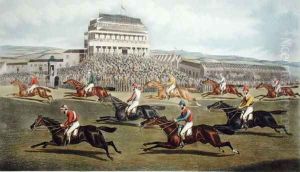Charles Hunt and Son Paintings
Charles Hunt was a Victorian-era British painter known for his genre scenes, often with a humorous or sentimental tone. Born in 1803, he developed a style that was popular in the mid-19th century, focusing on depictions of domestic life, children, and animals, which resonated with the Victorian middle class.
Hunt's works were characterized by their detailed narrative content, capturing the everyday life of his era with a keen eye for detail and character. He was adept at portraying the innocence of childhood as well as the amusing aspects of family life. His paintings often included a moral or didactic element, which was a common feature in Victorian art.
The 'and Son' in 'Charles Hunt and Son' refers to his son, Charles Hunt Jr., who was also an artist and followed in his father's footsteps. Charles Hunt Jr. was born in 1829 and continued the family tradition, painting similar subjects and often collaborating with his father on various artworks. Together, they contributed to the Victorian era's rich tapestry of genre painting, though it's important to note that the son's work is less well-documented and often overshadowed by the father's reputation.
Charles Hunt Sr. exhibited his work at the British Institution, the Royal Academy, and other venues, which were central to the art world in London at the time. He enjoyed a successful career and was well-regarded by his contemporaries. He passed away in 1877, leaving behind a legacy of charming genre scenes that provide a window into the social dynamics and daily life of Victorian England.
The father and son duo often signed their works simply as 'Charles Hunt,' which can sometimes make it difficult to distinguish between their individual contributions. However, their work remains a testament to the genre painting tradition of the 19th century, and their paintings are still appreciated by collectors and historians for their narrative quality and historical value.
